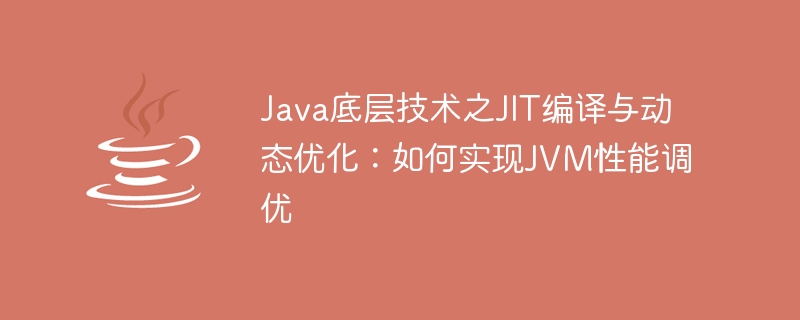

JIT compilation and dynamic optimization of Java underlying technology: How to implement JVM performance tuning requires specific code examples
Introduction:
With the development of the Java programming language Widely used, performance tuning for Java Virtual Machine (JVM) has become an important task that cannot be ignored. In the JVM, JIT (just-in-time compiler) compilation and dynamic optimization are one of the key technologies to improve the performance of Java programs. This article will introduce the principles of JIT compilation and dynamic optimization in detail, and explore how to achieve JVM performance tuning through specific code examples.
1. Overview of JIT compiler
JIT compiler (Just-In-Time Compiler) is a compiler that directly compiles the interpreted and executed bytecode into local machine code at runtime. The JIT compiler adopts a delayed compilation strategy, which means that methods or code blocks will only be compiled into machine code when they are frequently executed, thereby improving program execution efficiency.
2. JIT compilation process
The process of JIT compilation is mainly divided into three stages: interpretation and execution stage, JIT compilation stage and local machine code execution stage.
3. Dynamic optimization of JIT compiler
In addition to converting bytecode into machine code, the JIT compiler also provides a series of optimization technologies to further improve program performance. Commonly used dynamic optimization techniques include: method inlining, escape analysis, loop optimization, code elimination, etc.
Sample code:
public class InlineExample {
public static void main(String[] args) {
int result = addNumbers(10, 20);
System.out.println("Result: " + result);
}
private static int addNumbers(int a, int b) {
return a + b;
}
}In the above example code, the JIT compiler can directly embed the addNumbers method through method inlining mainThe calling point of the method, thus avoiding the overhead of method calling.
Sample code:
public class EscapeAnalysisExample {
public static void main(String[] args) {
for (int i = 0; i < 100000; i++) {
allocateObject();
}
}
private static void allocateObject() {
Object obj = new Object();
}
}In the above example code, the JIT compiler can allocate the Object object on the stack based on the results of the escape analysis to avoid Eliminates the overhead of heap allocation and garbage collection.
Sample code:
public class LoopOptimizationExample {
public static void main(String[] args) {
int sum = 0;
for (int i = 1; i <= 100; i++) {
sum += i;
}
System.out.println("Sum: " + sum);
}
}In the above example code, the JIT compiler can expand the loop into the following form:
int sum = 0; sum += 1; sum += 2; ... sum += 100;
Thus reducing the number of iterations of the loop , improving the execution efficiency of the program.
4. JVM performance tuning practice
In actual applications, JVM performance tuning can help improve the performance and stability of applications. The following are several suggestions for optimizing JVM performance:
Actual performance tuning needs to be carried out according to specific application scenarios. We need to analyze and test based on the actual situation to identify performance bottlenecks and optimize them.
Conclusion:
JIT compilation and dynamic optimization are one of the key technologies to improve the performance of Java programs. By utilizing the dynamic optimization capabilities of the JIT compiler, we can achieve performance tuning of the JVM. This article introduces the basic principles of JIT compilation and dynamic optimization, and shows how to implement JVM performance tuning through specific code examples. It is hoped that readers can have a deeper understanding of JIT compilation and dynamic optimization through the introduction and examples of this article, and can use it flexibly in practice to improve the performance of Java applications.
The above is the detailed content of JIT compilation and dynamic optimization of Java underlying technology: How to achieve JVM performance tuning. For more information, please follow other related articles on the PHP Chinese website!




